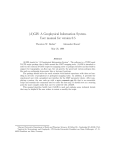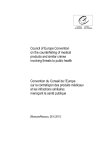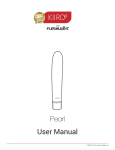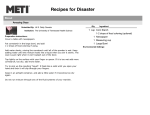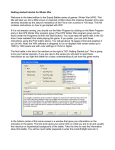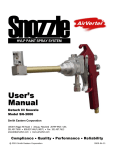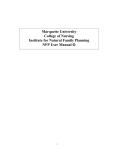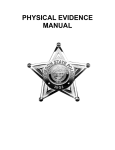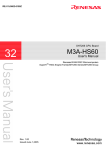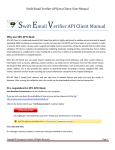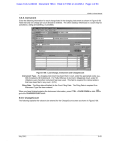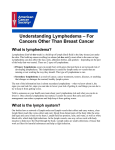Download SEXUAL ASSAULT EVIDENCE KIT (SAEK) INSTRUCTIONS
Transcript
SEXUAL ASSAULT EVIDENCE KIT (SAEK) INSTRUCTIONS Exam and treatment protocol and directions for evidence collection from sexual assault patients Revised July 2005 READ DIRECTIONS COMPLETELY PRIOR TO PERFORMING EXAM! AT NO TIME SHOULD A MEDICAL FACILITY SUBMIT AN INVOICE FOR THE SEXUAL ASSAULT EVIDENCE KIT WHERE A PHYSICIAN SIGNS OFF ON A SEXUAL ASSAULT MEDICAL EXAM FOR WHICH A NURSE PERFORMS. IDEALLY, SEXUAL ASSAULT PATIENTS SHOULD BE EXAMINED BY EXPERIENCED NEW MEXICO SEXUAL ASSAULT NURSE EXAMINERS (SANE). A LIST OF NEW MEXICO SANE PROGRAMS WITH CONTACT INFORMATION IS ON PAGE 9. IF YOU ARE RESPONDING TO CHILD SEXUAL ABUSE, READ PAGE 9 FIRST! IF PATIENT NEEDS TO URINATE & DRUG FACILIATED RAPE IS SUPECTED, READ PAGE 4. PRE-EXAM CONSIDERATIONS Priority Priority should be given to examine the sexual assault patient. Initially, triage the patient for medical needs, safety, and comfort before proceeding with the forensic exam. Medical stability is the priority; the sexual assault exam is secondary to any necessary medical response. Please note that medical stability is an on-going process during the sexual assault exam. Advocate Call your local advocacy program to provide the patient with a support person to be present during the forensic interview and exam. The advocate’s role is essential during this procedure. The trained advocate can help with referrals, case management, long-term recovery and psychological healing of the patient. If you are responding to a patient who came from a facility, do not use an employee of the facility as an advocate. Consent After reading these instructions, explain the forensic examination to the patient and obtain consent for the following specific procedures allowing the patient to decide what procedures he/she will allow: Full (evidence collection and medical treatment) or limited (medical treatment) exam Documentation of injury, which may include photography and colposcope Pregnancy testing, STD Prophylaxis, and Emergency Contraception Urine collection for Drug Facilitated Sexual Assault Release of evidence and/or reporting to law enforcement Referral to child safe house and/or appropriate pediatric medical agency for age appropriate patients The patient is under no obligation to report the assault to the police or to undergo the sexual assault exam. Counsel the patient that collection of evidence is recommended even if they do not think that they want to press charges at this time. Ensure that the patient realizes that preservation of evidence is time sensitive and that now is the optimal time to collect. New Mexico SAEK Instructions, July 2005 Page 1 of 10 In the event the patient wants evidence collected, but at the time of the exam does not wish to have the case investigated by law enforcement, it is important to inform the patient that any collected evidence will be stored by the appropriate crime lab. For the crime labs to accept evidence, an information report must be filed with the appropriate law enforcement agency which is responsible for transferring the evidence. The information report will include, at minimum, the patient’s name, date of birth, and most likely a reference to sexual assault. Like all police reports, the information report is public record. The patient is under no obligation to speak to law enforcement at the time of the exam or participate in an investigation. The information report does not automatically result in an active investigation, but rather facilitates the transfer and storage of evidence. If the patient decides to pursue an active investigation, he or she must contact the appropriate law enforcement agency to initiate the investigation. The advocate may be able to help the patient with initiating the investigation. If the patient decides against evidence collection, a limited exam can be offered. A limited exam includes medications for STD prophylaxis and Emergency Contraception and you would not need the SAEK. With patient consent, pregnancy testing with subsequent emergency contraception and STD prophylaxis may be provided. The patient still has the option to return within 5 days post assault for a full sexual assault evidence exam. If the patient wants to file a police report, notify law enforcement. The advocate should remain with the patient during the investigative interview with police. Exam Payment Inform the patient that the evidence collection portion of the exam will be paid in full by the State of New Mexico and up to $150.00 of the medical treatment is covered by the State fund. At no time should your facility submit an invoice for the Sexual Assault Evidence Kit where a physician signs off on a sexual assault medical exam for which a nurse performs. The hospital or clinic (not the patient) should submit billing to: NMCSAP/SCPTP 3909 Juan Tabo NE, Suite 6 Albuquerque, NM 87111 If a billing packet or more information is required, call the NMCSAP toll free number at 888-883-8020. If additional medical treatment charges are incurred, inform the patient that he/she may be held responsible for the medical portion of the charges (injury repair, prescriptions, etc). The patient may apply for additional funding to cover the medical treatment from Crime Victims Reparation Commission (841-9432) if a police report is filed. (The number for the Commission is also in the enclosed “From Victim to Survivor” brochure.) CHAIN OF CUSTODY READ! IMPORTANT!! Chain of custody refers to the examiner’s ability to testify under oath that the evidence could not have been tampered or compromised in any way during its collection, packaging, storage, or transfer. Chain of Custody must be maintained at all times once the Sexual Assault Evidence Kit is opened. This means the examiner must stay with the evidence collected during the exam until all evidence has been properly sealed and secured. Chain of Custody includes an Integrity Seal, which is the assurance that the examiner is responsible for collecting and packaging the evidence. The Integrity Seal is the examiner’s initials and the date of collection written over the taped seal of the SAEK small and large White Envelopes and large Brown Bag. Once sealed, evidence should be signed over to law enforcement. If this is not possible, evidence may be signed over to the next shift at your medical facility. The next individual must take full responsibility for the evidence until law enforcement is able to retrieve the SAEK White Envelope and Brown Bag. Every individual who assumes responsibility for any evidence must document the handling and transfer of that evidence. It is acceptable to keep the kit in an area that is locked securely. Ideally, law enforcement should obtain the completed kit as soon as possible following the exam. New Mexico SAEK Instructions, July 2005 Page 2 of 10 SEXUAL ASSAULT EVIDENCE KIT (SAEK) EXAM Obtain a Sexual Assault Evidence Kit (SAEK). It is critical that the integrity of the SAEK is intact. Read these Sexual Assault Instructions completely prior to starting the sexual assault exam. Use Personal Protection Equipment (gloves) while collecting evidence to prevent cross-contamination and change gloves frequently during the sexual assault exam. The patient’s history is critical in directing the examiner’s collection of evidence. Specimens are collected from orifices or sites the patient indicates were involved in the sexual assault. Exceptions would be pediatrics, drug-facilitated assault, patients with no memory or ability to verbalize the alleged assault, and/or if the examiner observes injuries or findings. For these exceptions where the evidence is collected by the examiner but not reported by the patient, write on the outside of that envelope “Collected Not Reported.” Sexual Assault History Form Obtain history of assault and relevant data as directed by the enclosed Sexual Assault History Form. Complete as much information as possible on the History Form. Print clearly and legibly. When asking the patient to give a description of the assault, DO NOT ASK LEADING QUESTIONS that lead to yes or no answers such as, “Were you raped?” Instead, ask the patient “What happened?” or “Can you describe the incident to me?” Let the patient use his/her own words and use those words in your charting. Documentation of the patient’s account of the assault must be the patient’s verbatim statement. Use quotations to indicate patient’s actual statements. It is critical that no re-phrasing occur. Let the patient know that for evidence collection you need to ask specific questions about which of the suspect’s body parts touched the patient’s body parts. History is for diagnosis and treatment of the patient and to direct the collection of evidence. LAW ENFORCEMENT WILL DO THE INVESTIGATIVE INTERVIEW. The examiner should avoid using the word “rape” in discussing any conclusions. Use the words “sexual assault” or “assault.” Exam Room Preparation/Supplies Prepare room by gathering equipment and supplies so that the exam may be conducted uninterrupted. Supplies include speculum, sterile water, extra sets of gloves, blood drawing supplies, vital sign supplies, ruler for measuring injuries, black marker/Sharpie, a stable stand for holding/air-drying the swabs, and clothing for the patient to wear post exam. An easy makeshift stand for holding and airdrying the swabs is to turn a Styrofoam cup upside down and pierce four holes per cup to hold the 4 swabs collected; make and label a cup for each orifice (oral, anal, vaginal, penile, etc) that the patient reports penetrated. Equipment specific for a sexual assault exam includes a Colposcope, Toluidine Blue Dye, an Alternative Light Source/Woods Lamp, and a camera for photography. If these are not readily available in your hospital facility, proceed with the SAEK collection using the supplies that you have. Open the kit, lay out envelopes that you will use (based on patient narrative), and label each envelope completely and legibly. Label envelopes and bags before placing evidence inside: this minimizes the destruction of evidence and prevents the mix-up of evidence samples. Complete the information on the front of the SAEK White Envelope and Brown Bag. Once you have opened the SAEK, you must maintain “Chain of Custody.” The examiner is responsible for the evidence. The examiner must stay with the evidence collected during the exam until all evidence has been properly sealed and secured. Evidence is never to be left alone with the patient, family, friend, legal guardian, or advocate. (Refer to Chain of Custody on page 2.) Show the patient the room and supplies, and answer any additional patient questions. Allow the patient to have a person of their choice in the exam room to support them during the process. This may be the trained advocate or a friend/family member. New Mexico SAEK Instructions, July 2005 Page 3 of 10 Clothing/Patient Disrobing The patient is under no obligation to forfeit his/her clothing for evidence. This is entirely the patient’s decision. Advise the patient that he/she may not receive clothing back and if it is returned, it will likely be damaged from lab tests. Explain to the patient that body fluids, hair, and/or trace fibers found on the clothing may contain critical information. Even if the patient has changed clothing, it may be useful to collect the underwear worn to the exam, as the underwear may contain drainage from post-assault. Inspect clothing for any tears, stains, and debris and document condition of clothing on the History Form. Be careful not to lose any trace fibers from the clothing. Photographs of torn or bloodied clothing can support documentation. Wet clothing may need to be temporarily laid out for drying and packaging at a later time; this must occur in a secured area. Document this in your charting. Place two large sheets of paper on the floor, one on top of the other (the bottom sheet keeps the top sheet clean; the bottom sheet will be thrown away while the top sheet and any debris/trace fibers will be saved in the pre-labeled Floor Sheet bag). Do not use chux or any plastic sheeting. Have the patient remove their shoes prior to having them disrobe. While standing barefoot on the Floor Sheet, the patient can disrobe and drop clothes gently in the middle of the Floor Sheet. These will be the clothes collected for evidence. If the patient declines submitting his/her clothes for evidence, have patient lightly shake clothes over the Floor Sheet for any potential trace fibers and lay the clothes aside. Allow patient to determine what pieces of clothing will be left for evidence. Give patient a hospital gown to wear during the subsequent exam. Patient Assessment and Urine Collection Obtain the patient’s vital signs. If abnormal, recheck and take appropriate action. Injuries causing pain or serious discomfort should be treated before starting the sexual assault exam. If a drug-facilitated rape is suspected, urine may need to be collected and preserved. Urine may be collected up to 96 hours post-assault. Have the patient urinate into a tamper-resistant, urine specimen container or cup that can be securely sealed. Label container with patient information. Obtain a urine specimen for pregnancy test on all patients of childbearing age. If the specific gravity of the urine is <1.015, a serum pregnancy test should be sent to the lab to assure accurate results. Perform a head-to-toe assessment for evidence of trauma to the body and patient complaint of pain, working your way literally from “head to toe.” Pay particular attention to any area of concern based on the mechanism of injury and patient’s history of assault. Document all injuries. Measure and describe all injuries indicating location of the injuries. Use the Body Map that is part of the Sexual Assault History Form. If available, photographic documentation of injuries is strongly recommended. Blood Standard Draw blood specimen, approximately 0.5ml and transfer to pre-labeled card that is in the pre-labeled Blood Standard envelope. Blood stain should be about the size of a nickel or quarter coin. Allow to air dry. Do not use heat to dry. Dry in a secure place to minimize cross-contamination. Once dried, place this swatch into the pre-labeled Blood Standard envelope. Head Hair Standard Pull at least twenty-five (25) head hairs and place in the pre-labeled Head Hair Standard envelope. Pull by hand near the patient’s scalp. Include the root of the hair from different areas on the scalp, such as the front, middle, back, and both sides. Include grey hair. Be sure to collect various lengths and color samples. Hairs must be pulled. Scissors or tweezers damage the hair and the root is needed. If head hairs adhere to the examiner’s gloves, place the entire glove in the pre-labeled Head Hair Standard envelope. New Mexico SAEK Instructions, July 2005 Page 4 of 10 Oral Swabs Inspect the oral cavity first, documenting any injuries. Photograph noted injuries. If oral penetration is reported and/or suspected, swab gum line, margin between gums and cheek, the crevices between teeth, and under the tongue with cotton swabs provided in the Oral Swabs envelope. Do one swab at a time. Use the entire surface of each cotton-tip swab to maximize the amount of sample collected. Mark the first swab obtained with a black marker/Sharpie on the distal wooden portion of the swab stick. Place the swabs in a stable stand and let the 4 swabs air-dry. Once dried, place all 4 swabs back into the pre-labeled Oral Swabs envelope. Genital Exam Place the patient in the appropriate position of comfort, dependent on age, to optimally allow you to visualize and perform the vaginal/rectal/penile examination. Inspect external genitalia and rectal area for visual signs of trauma. Document injuries on the Genital Map of the History Form and photograph injuries before obtaining any swab collection. If you are using a Colposcope, injury documentation should be done prior to obtaining any swabs. You will want to save the Table Sheet that the patient sat on while on the exam table as evidence. Pubic Hair Combings and Comb The pubic hair may contain dried secretions from drainage or ejaculation. If the pubic hair is matted, representative samples should be cut and packaged separately in a pre-labeled Miscellaneous envelope. Clearly mark on the Miscellaneous envelope what was collected and from where. Comb the patient’s pubic hair over the pre-labeled Pubic Hair Combings and Comb envelope so that the hair falls into the opened envelope. When complete, place comb back into envelope. You may ask the patient if he/she would prefer combing him/herself; however, the examiner must observe the combing. Anal Swabs If rectal penetration is reported and/or suspected, examine the anal area first. Examination and evidence collection of the anal area is performed prior to genital because this area can be contaminated when inspecting and collecting vaginal specimens. Examine the rectal area for injury and document any noted injuries prior to obtaining swabs. Remove any foreign bodies and let air-dry before placing in envelope marked Miscellaneous. Clearly document on the Miscellaneous envelope where the evidence was obtained from. Obtain swabs of the rectal area with the cotton swabs provided in the envelope marked Anal Swabs. Indicate on the Anal Swab envelope whether swabs are collected from outer anal folds or from within the orifice. If both situations exist, package in separate envelopes and clearly mark the envelope where evidence was collected. Do one swab at a time. Use the entire surface of each cotton-tip swab to maximize the amount of sample collected. If particulate matter/fibers are on the swab, do not remove from the swab. Mark the first swab obtained with a black marker/Sharpie on the distal wooden portion of the swab stick. Place the 4 swabs in a stable stand and let the swabs air-dry. Once dried, place all 4 swabs back into the pre-labeled Anal Swabs envelope. Vaginal Swabs If vaginal penetration is reported and/or suspected, examine the vaginal area for injury. Document injuries on the Genital Map of the History Form prior to inserting the speculum. New Mexico SAEK Instructions, July 2005 Page 5 of 10 Insert speculum and inspect for injury or foreign bodies. Document any injury within the vaginal canal. Colposcope documentation should be done prior to obtaining any swabs. Remove any foreign bodies and let air-dry before placing in envelope marked Miscellaneous. Clearly document on the Miscellaneous envelope where the evidence was obtained from. Obtain swabs of the vaginal area with the cotton swabs provided in the envelope marked Vaginal Swabs. Indicate on the Vaginal Swab envelope whether swabs are collected from outer labial folds or from within the orifice. If both situations exist, package in separate envelopes and clearly mark the envelope where evidence was collected. Do one swab at a time. Use the entire surface of each cotton-tip swab to maximize the amount of sample collected. If particulate matter/fibers are on the swab, do not remove from the swab. Mark the first swab obtained with a black marker/Sharpie on the distal wooden portion of the swab stick. Place the 4 swabs in a stable stand and let the swabs air-dry. Once dried, place all 4 swabs back into the pre-labeled Vaginal Swabs envelope. Cervical Swabs Examine the cervical area for injury. Colposcope documentation should be done prior to obtaining any swabs. Obtain swabs of the cervical os with the cotton swabs provided in the envelope marked Cervical Swabs. Do one swab at a time. Use the entire surface of each cotton-tip swab to maximize the sample collected. Mark the first swab obtained with a black marker/Sharpie on the distal wooden portion of the swab stick. Place the 4 cervical swabs in a stable stand and let the swabs air-dry. Once dried, place all 4 swabs back into the pre-labeled Cervical Swabs envelope. Male Genitalia Swabs If the patient is male and dependent upon patient history, collect penile, scrotum, and/or urethral swabs. The examiner will swab the primary source of potential foreign DNA. This may include the penile shaft, glans, scrotum, and/or urethral opening. Re-label the cervical and/or vaginal envelope to read “Penile.” Use the swabs that are in that envelope. Do one swab at a time. Use the entire surface of each cotton-tip swab to maximize the sample collected. Mark the first swab obtained with a black marker/Sharpie on the distal wooden portion of the swab stick. Place the 4 penile swabs in a stable stand and let the swabs air-dry. Once dried, place all 4 swabs into pre-labeled Male Genitalia Swabs envelope. Miscellaneous Evidence If there is any other evidence such as blood, dried secretions, loose hairs, material fibers, environmental debris (vegetation, dirt, gravel, glass), and/or tampons, collect, dry, and place in a pre-labeled Miscellaneous envelope. Clearly label the envelope to describe where evidence was collected. If the patient reports scratching the suspect, swab under the patient’s fingernails with swab(s) that have been moistened with sterile water. Use one or two swabs per hand depending upon amount of visible debris. Use the entire surface of each cotton-tip swab to maximize the amount of sample collected. Place these swabs in a stable stand and let air-dry. Once dried, place swabs in a pre-labeled Miscellaneous envelope. If swabs are collected from both hands, package swabs collected from left and right hand in separate pre-labeled envelopes, with clear indication of where evidence was collected. If the patient reports any contact of bodily fluid, use swab(s) moistened with sterile water to collect samples from the patient’s body where contact was reported. This includes areas where the patient reports being bitten or licked. Use one or two swabs per body part that patient reports contact. Use the entire surface of each cotton-tip swab to maximize the amount of sample collected. An Alternate Light Source or Woods Lamp may help visualize the body fluid. Place these swabs in a stable stand and let New Mexico SAEK Instructions, July 2005 Page 6 of 10 air-dry. Once dried, place swabs in a pre-labeled Miscellaneous envelope, indicating where the evidence was collected. MEDICATIONS Preventative medications for emergency contraception and sexually transmitted infections should be offered to adults and for adolescents where child sexual abuse is not suspected. Testing for STD’s in adults/adolescents for sexual assault is not required. Medications should be offered as a prophylactic measure. Attached (page 10) is a summary of medications that can be offered for Sexually Transmitted Diseases (STD) and Emergency Contraception. For a thorough guide on STD prevention and the recommended treatment for adolescents and adults, view Centers for Disease Control webpage at: www.cdc.gov/mmwr/preview/mmwrhtml/00050909.htm. PATIENT DISCHARGE Determine where patient is to be discharged and make appropriate arrangement for transportation. Complete discharge instructions and give both verbal and written instructions to patient. Inform patient concerning community referrals such as Planned Parenthood, Public Health Office, and New Mexico AIDS Services. Work with the trained advocate to identify appropriate referrals and resources. Enclosed in this kit is the brochure “From Victim to Survivor.” Listed on the back are contact numbers for local rape crisis services. Most programs offer four or five therapy sessions at no cost to survivors of sexual assault. The brochure has information about the New Mexico Crimes Reparation Commission, a state agency that can offer financial compensation for victims of crime. Be certain that the patient is given this brochure when discharged. SEALING EVIDENCE Clothing, Floor/Table Sheets, Small and Large Brown Bags Plastic bags should never be used for packaging evidence. Plastic retains moisture which allows the growth of bacteria and causes degradation of biological fluids. Use paper bags only. Place air-dried underwear in the pre-labeled Undergarments bag. Fold the top of the bag over twice and staple across the final fold. Place this secured bag in the larger pre-labeled Brown Bag. Place remaining air-dried clothing in the large pre-labeled Brown Bag. Fold Floor Sheet inward into small squares (to contain debris/loose evidence) and place in the prelabeled Floor Sheet bag. Fold the top of the bag over twice and staple across the final fold. Place this secured bag in the larger Brown Bag. Fold Table Sheet inward into small squares (to contain debris/loose evidence) and place in pre-labeled Table Sheet bag. Fold the top of the bag over twice and staple across the final fold. Place this secured bag in the larger Brown Bag. Once all the Undergarments, Table Sheet, Floor Sheets bags and clothing are inside the large Brown Bag, fold the top of the large Brown Bag over twice and staple across the top of the final fold. Tape across this fold. The examiner must initial and date across the tape so that the writing overlaps from the tape onto the bag. The Crime Labs in New Mexico cannot accept evidence that does not have both the examiner’s initials and the date across the taped seal. The examiner must complete the front label of this Brown Bag with signature, date, and time collected. Swabs, Hair, Blood, Small Envelopes and Large White SAEK Envelope To preserve evidence, the swabs must be air-dried prior to packaging. Biological evidence degrades rapidly with moisture. Do not use heat to dry. Place all dry swabs in their appropriate pre-labeled envelopes. New Mexico SAEK Instructions, July 2005 Page 7 of 10 Seal all small white envelopes with a damp paper towel or water-moistened gloved finger. Never lick envelopes! Tape across the sealed flap of the envelope. The examiner must initial and date across the tape so that the writing overlaps from the tape onto the envelopes. Insert the sealed small white envelopes into the larger pre-labeled white SAEK Envelope. Insert the completed Sexual Assault History form and the completed SAEK Check List into large white SAEK Envelope. Seal this larger envelope with a damp paper towel or water-moistened gloved finger and tape across the sealed flap. The examiner must initial and date across the tape so that the writing overlaps from the tape onto the envelope. The Crime Labs in New Mexico cannot accept evidence that does not have both the examiner’s initials and the date across the taped seal. The examiner must complete the front of the large white SAEK Envelope with signature, date and time collected. Clearly indicate on the outside of the large white SAEK Envelope and the large Brown Bag by filling in “Item 1 of 2” on the white SAEK Envelope and “Item 2 of 2” on the large Brown Bag. Other Evidence Collected: Film and/or Urine Do not put urine or film into the SAEK Envelope or Brown Bag. Clearly mark urine and film with patient information and transfer to law enforcement as separate items, along with the SAEK Envelope and Brown Bag. Law enforcement is responsible for the processing of film. Law enforcement is responsible for transferring the SAEK Envelope, Brown Bag, Film and/or Urine to their appropriate Crime Lab. ORDERING SEXUAL ASSAULT EVIDENCE COLLECTION KITS The kits and packets should be treated as any other medical supply. Consistent, up-to-date inventory of Sexual Assault Evidence Kits in your medical facility will help prevent emergency requests for kits, which are usually impossible for the NMSCAP to fill. Please allow two weeks for delivery. Kits are free of charge to medical facilities within New Mexico. They may not be sold under any circumstances. You may order as many kits as you need and are able to store. Evidence kits for the suspected offender are also available. These kits are designed, updated and assembled by the New Mexico Coalition of Sexual Assault Programs, Inc. with funding from the State of New Mexico, Department of Health, Division of Mental Health. This current version was updated in June of 2005 and is so noted on the outside of the SAEK envelope. Please contact the coalition if you would like a staff in-service on evidence collection. You may also contact the Coalition if you need sample protocols for Chain of Custody or other aspects of conducting a sexual assault exam. CONTACT New Mexico Coalition of Sexual Assault Programs, Inc. (NMCSAP) 3909 Juan Tabo NE, Suite 6 Albuquerque, NM 87111 Toll-free, 1-888-883-8020 outside the Albuquerque calling area and 883-8020 in the calling area SEXUALLY ABUSED CHILDREN If the patient is under the age of eighteen years and there is a suspicion of child sexual abuse by a caregiver, family member, or person in authority, Child Protective Services (Tribal or Children, Youth, and Family) must be contacted. Not reporting suspected child abuse and neglect (including sexual abuse) is a crime. When filing New Mexico SAEK Instructions, July 2005 Page 8 of 10 the report, inform Statewide Central Intake if the alleged perpetrator has continued access to the child. Call the Statewide Central Intake toll-free 1-800-797-3260 or 841-6100 in the Albuquerque area. A physician does not need the permission of a parent to do evidence collection on a child who has been sexually abused. Evidence in sexual crimes is considered “fleeting” and thus does not require a search warrant. The child is considered the “crime scene.” A parent or guardian can be charged with aiding and abetting an alleged perpetrator by not allowing the exam. The primary differences in using this Sexual Assault Evidence Kit with Child Sexual Abuse are • The window for evidence collection is up to 72 hours while for adolescents/adults, the window is up to 5 days. • The examiner does not treat for sexually transmitted infections. Sexually transmitted infections are evidence of the crime of sexual abuse. Cultures must be obtained prior to treatment with antibiotics. • The examiner does not need to take a Blood Standard for patients under 13 years of age. Instead, the examiner should first take the appropriate Oral Swabs if oral penetration is suspected. Then, have the child rinse his/her mouth thoroughly. Clearly mark a Miscellaneous envelope with the patient’s name and “Buccal Standard.” Lastly, the examiner takes one swab to wipe the inside, fleshy part of the cheek. Use the entire surface of the cotton tip swab to maximize the amount of the child’s buccal saliva obtained. Place the swab in a stable stand and let air-dry before placing it in the pre-labeled envelope. • The examiner will not insert a speculum exam on a pre-pubescent child. • The examiner should ask the child where secretions may have been left on their body and then swab those areas. The folds and creases in the child’s vulvar area may be wiped with swabs to collect evidence if indicated. • Photographs are critical documentation of a child’s injuries. • In documenting the history in the History Form, the examiner must use the child’s direct quotes rather than the examiner’s interpretation of the child’s statement. NEW MEXICO SEXUAL ASSAULT NURSE EXAMINER (SANE) PROGRAMS with emergency contact information • Albuquerque SANE, 505-884-7263 • Santa Fe SANE, 505-989-5952 • Las Cruces SANE, 888-595-7273 • Roswell/Chaves County SANE, 505-625-1457 • Farmington/San Juan County SANE, 505-326-4700 • Clovis/Curry County SANE, 505-769-7335 • Portales/Roosevelt County SANE, 505-359-1800 • Alamogordo/Otero County SANE, 505-443-2156 New Mexico SAEK Instructions, July 2005 Page 9 of 10 Suggested Medications for Sexual Assault Patients for STD Prophylaxis and Emergency Contraception Gonorrhea Prophylaxis in Adolescents and Adults (Female and Male) Ciproflaxin (Cipro) 500 mg PO x 1 • Do not administer if the patient is pregnant or nursing. Cefpodoxime Proxetil Vantin 400 mg PO x 1 • Administer if patient is allergic to Cipro. • Safe if pregnant or nursing. • Administer if male anally or orally penetrated. Chlamydia Prophylaxis in Adolescents and Adults (Female and Male) Azithromycin (Zithromax) 1 Gram PO x 1 • Do not administer if patient is allergic to Erythromycin. • Safe if patient pregnant or nursing. Doxycycline (Vibramycin) 100 mg PO BID for 7 days • Administer if patient allergic to Zithromax. • Do not administer if the patient is pregnant or nursing. Amoxicillin 500 mg PO TID x 7 days • Administer if allergic to Erythromycins (Zithromax). • Safe if patient pregnant or nursing. Trichomonas Prophylaxis in Adolescents and Adults (Female) Metronidazole (Flagyl) 2 grams PO x 1 • Do not administer if ETOH has been ingested within 24 hours. • Do not administer this medication if the patient is pregnant or nursing. • If pregnant and nursing no treatment. Emergency Contraception in Adolescents and Adults (Female) Levonsorgestrel (Plan B) 2 tablets (0.75 mg each) PO before the patient is discharged from the SANE Unit. • Do not give after 5 days (120 hours) of assault. • Do not give if patient is pregnant. • Safe if patient nursing. • Must obtain a urine pregnancy test prior to administering Levonorgestrel. • Offer Emergency Contraception even if patient on birth control (Depo, BCP, Patch, Tubal ligation, Post-Menopausal, or Hysterectomy, etc.). • New Mexico Law requires that the health care facility inform the patient about emergency contraception and provide the medication if requested by the patient Anal Discomfort Treatment in Adolescents and Adults (Female and Male) Docusate Sodium (Colace) 100 mg capsule PO once daily for 7 days as a take home medication for patients who have been rectally penetrated. Tucks 1 Pad up to six times daily for 7 days as needed for hemorrhoids as a take-home medication. • Do not administer if allergic to witch-hazel. New Mexico SAEK Instructions, July 2005 Page 10 of 10













